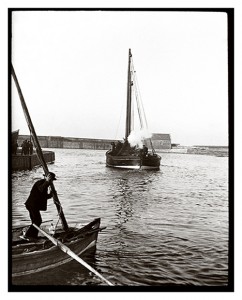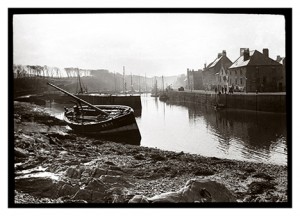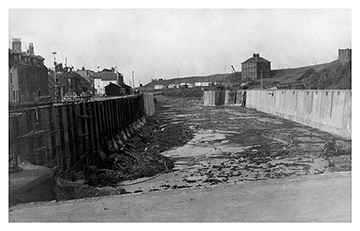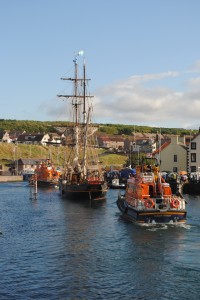Early Days:

The earliest mention of Eyemouth is in a 12th Century charter granting the Prior and Monks of Coldingham two tofts of land “at Eiemuthe”. There had probably been a settlement at the mouth of the River eye before this, being the only sheltered haven on this part of the coast, but there are no written records of this. We must imagine a single line of low stone built houses, with straw or heather thatch, along the line of the River Eye and foreshore. Small fishing boats, propelled by oar or a single sail would have been drawn up on the beach or river bank.
There was a Harbour Master as far back as 1214. John Kinghorn was his name and he was summonsed to appear in court at nearby Ayton to answer a charge of exacting “12 pennies more than was due for the anchorage of a ship at Eyemouth”
1700’s:
The Old Pier:
The first artificial improvement to the harbour came in 1747, when William Craw of Netherbyres built what was known as the Old Pier. Not only did he design the pier, but he contributed largely towards the cost of construction. This pier was designed not only to give additional shelter, but also to try to cure the problem of sand building up at the entrance to the harbour, a problem which still exists to this day. After its construction “the trade of the seaport greatly increased. Instead of barques and sloops, the harbour could accommodate large coasting vessels and Eyemouth became a powerful rival to Berwick as a shipping centre” (McIver “An Old Time Fishing Town”).
The Smeaton Pier:
The Old Pier was destroyed by a great storm after only twenty years, in 1767. This storm was so severe that five ships were driven so far up the harbour that they could not be re-floated. The debris of the old pier lay across the harbour entrance thereby obstructing it. A celebrated engineer Mr Smeaton was called in, and built what was then called the ‘New Pier’ on the South side of the harbour. The Smeaton Pier was begun in 1769 and completed in 1773. The whole cost was £2,100. It has successfully served the purpose of a breakwater ever since, being incorporated into the new harbour development at the seaward side of the new Gunsgreen deep water berth, opened in 1999.
The Great Disaster 1881:
October 14th, 1881 also known as Black Friday is a day etched into Eyemouth’s history. 189 men were killed in a hurricane (many in view of their loved ones on the shore) which devastated the Berwickshire Coastal Communities in a single afternoon.
The Great Disaster, the story of which is told in Eyemouth Museum , led to a campaign for a deeper and safer harbour. Messrs. Meek & Sons of Edinburgh produced a design which would have cost £82,891. However, Eyemouth had to be content with something less, as the Harbour Trust could only raise a loan of £25,000. With this sum the harbour was extended in area, the middle pier constructed and the rocks cut on the Gunsgreen side to make way for the river.
The work began in 1885 and was completed in 1887, the basin of the harbour being deepened about two feet, while its area was extended to 9 ½ acres.
Further work took place in 1892/3, when the entrance to the harbour was deepened by about 3 feet and improvements made to the quay walls.

Early 1900’s:
A design study in 1912 proposed a new harbour entrance and a deep water basin below Gunsgreen House, but funds could not be raised. This design was very close to that carried out some 90 years later.
The two problems of shelter from wind & sea, and the restricted entrance due to the buildup of sand, have been the major concern of the Harbour Trustees over the decades. The original 1882 proposals put forward by Messrs Meek & Son might have gone a long way to solving them had the funds been available.
A new breakwater and deep harbour entrance were eventually constructed in 1963/64. This involved the closure of the harbour with a coffer dam.
The 80’s & 90’s:
Eyemouth harbour continued to flourish, but its success brought its own problems – those of congestion and, with the advent of even larger fishing boats, the restricted harbour entrance. In 1982 a deep water basin and new harbour entrance were proposed, which would have cost over £17million. This was the start of a long campaign to persuade the Scottish Office to approve the proposal and produce the funds for the project. It became apparent the original proposal was too expensive, so in 1993 a revised proposal was put forward to deepen the existing entrance and to excavate a new deep water basin below Gunsgreen House, at a cost of just less than £4 million.
In addition a new fish market would be built to replace the existing one which no longer met hygiene regulations.
Work on the new harbour started in 1997 and was completed in 1999. The new Gunsgreen basin was opened by H.R.H The Prince of Wales on the 9th June 1999. The fishmarket was then completed and opened in March 2000.

Today:
We are the largest and most secure harbour in the area and offer 24-hour, lock-free access to a deep-water berthing facility. There is ready access to all essential services and supplies for fishing, leisure and commercial boats as you would expect from a busy working harbour. There is a fishing fleet of approximately 20 vessels, ranging from small creel boats to larger trawlers, increasing in the summer months when English vessels come north.
The past year has seen increased usage by commercial vessels, including those transiting to Leith / Dundee area, as well as offshore wind workboats and survey vessels carrying out early work on the proposed Firth of Forth and Tay offshore wind sites.
The harbour also plays host to an increasing number of touring leisure craft and there are two fully serviced pontoons available (totalling 230m) with disabled access, water and electricity.
There’s always something going on around the harbour…
In the summer you can bring the family to watch the bustling harbour, buy an ice cream or feed the seals. A number of businesses operate leisure trips from the harbour or you can visit one of a number of museums in the town.
The clear local waters offer world-class diving and the harbour provides an excellent access to the shoreline for divers.

